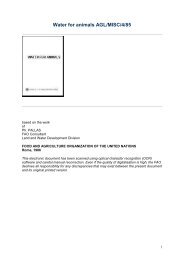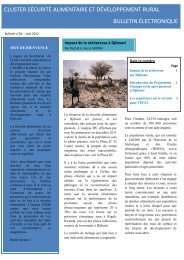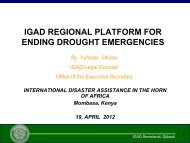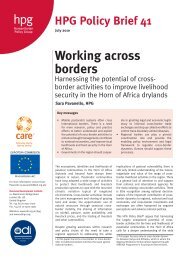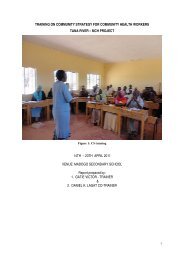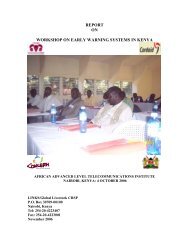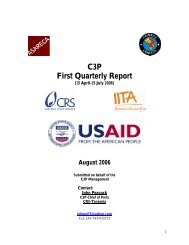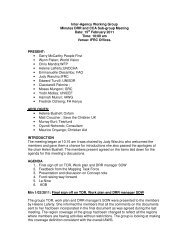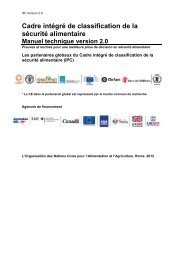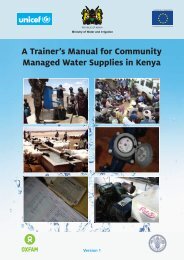In sum, pastoralism as a livelihood is a highly evolved ec<strong>on</strong>omic, social, cultural, <str<strong>on</strong>g>and</str<strong>on</strong>g> politicalresp<strong>on</strong>se to a l<str<strong>on</strong>g>and</str<strong>on</strong>g>scape where natural resources are highly variable in space <str<strong>on</strong>g>and</str<strong>on</strong>g> time. Insufficientattenti<strong>on</strong> to how pastoralists use <str<strong>on</strong>g>and</str<strong>on</strong>g> manage natural resources within this broader livelihoodc<strong>on</strong>text, <str<strong>on</strong>g>and</str<strong>on</strong>g> <strong>the</strong> lack <str<strong>on</strong>g>of</str<strong>on</strong>g> a coherent <str<strong>on</strong>g>and</str<strong>on</strong>g> streamlined approach to water development, <str<strong>on</strong>g>of</str<strong>on</strong>g>ten results inwater interventi<strong>on</strong>s which c<strong>on</strong>tribute to <strong>the</strong> disrupti<strong>on</strong> <str<strong>on</strong>g>of</str<strong>on</strong>g> elaborate <str<strong>on</strong>g>and</str<strong>on</strong>g> highly developed naturalresource management systems, <strong>the</strong> promoti<strong>on</strong> <str<strong>on</strong>g>of</str<strong>on</strong>g> unsustainable l<str<strong>on</strong>g>and</str<strong>on</strong>g> use, <str<strong>on</strong>g>and</str<strong>on</strong>g> heightened potentialfor c<strong>on</strong>flict, which serves to damage a very productive part <str<strong>on</strong>g>of</str<strong>on</strong>g> Ethiopia’s ec<strong>on</strong>omy. The ir<strong>on</strong>y <str<strong>on</strong>g>of</str<strong>on</strong>g>developing water to satisfy dem<str<strong>on</strong>g>and</str<strong>on</strong>g> is that as much as it can alleviate immediate pressures in <strong>the</strong>short term, it can potentially bring with it lasting <str<strong>on</strong>g>and</str<strong>on</strong>g> serious negative impacts in <strong>the</strong> l<strong>on</strong>g term. Thisoccurs when local needs, l<str<strong>on</strong>g>and</str<strong>on</strong>g> use patterns <str<strong>on</strong>g>and</str<strong>on</strong>g> ecological functi<strong>on</strong>s are not sufficiently c<strong>on</strong>sidered.In turn, water development can potentially undermine ra<strong>the</strong>r than promote development <str<strong>on</strong>g>and</str<strong>on</strong>g>sustainable livelihoods.Ways forwardThe type, size <str<strong>on</strong>g>and</str<strong>on</strong>g> placement <str<strong>on</strong>g>of</str<strong>on</strong>g> water points requires a solid underst<str<strong>on</strong>g>and</str<strong>on</strong>g>ing <str<strong>on</strong>g>of</str<strong>on</strong>g> 1) water needs <str<strong>on</strong>g>and</str<strong>on</strong>g>c<strong>on</strong>cerns in a given area, 2) <strong>the</strong> natural resource base which might be affected - as water points“functi<strong>on</strong> within <strong>the</strong> natural envir<strong>on</strong>ment <str<strong>on</strong>g>and</str<strong>on</strong>g> can potentially have significant harmful effects <strong>on</strong> it <str<strong>on</strong>g>and</str<strong>on</strong>g><strong>on</strong> <strong>the</strong> welfare <str<strong>on</strong>g>of</str<strong>on</strong>g> people depending <strong>on</strong> it” (Warner <str<strong>on</strong>g>and</str<strong>on</strong>g> Abate, 2005: 13), 3) <strong>the</strong> social as well aspolitical dynamics in areas <str<strong>on</strong>g>of</str<strong>on</strong>g> interventi<strong>on</strong>, 4) capacity at <strong>the</strong> local level to manage, operate <str<strong>on</strong>g>and</str<strong>on</strong>g>maintain water points, <str<strong>on</strong>g>and</str<strong>on</strong>g> 5) existing traditi<strong>on</strong>al water management systems already in place.Underst<str<strong>on</strong>g>and</str<strong>on</strong>g>ing <str<strong>on</strong>g>and</str<strong>on</strong>g> building <strong>on</strong> <strong>the</strong>se key elements is fundamental to help ensure that water schemeswill satisfy dem<str<strong>on</strong>g>and</str<strong>on</strong>g>, remain functi<strong>on</strong>al, <str<strong>on</strong>g>and</str<strong>on</strong>g> minimize envir<strong>on</strong>mental degradati<strong>on</strong> <str<strong>on</strong>g>and</str<strong>on</strong>g> c<strong>on</strong>flict. Thisnecessitates bringing communities <strong>on</strong> board at <strong>the</strong> outset <str<strong>on</strong>g>of</str<strong>on</strong>g> any planned interventi<strong>on</strong>.Following is an amalgamati<strong>on</strong> <str<strong>on</strong>g>of</str<strong>on</strong>g> three sets <str<strong>on</strong>g>of</str<strong>on</strong>g> guidelines 60 which could serve as a starting point toaddress <strong>the</strong> above issues. This example could also serve as a starting point to discuss <str<strong>on</strong>g>and</str<strong>on</strong>g> build <strong>on</strong> inorder to develop a comm<strong>on</strong> set <str<strong>on</strong>g>of</str<strong>on</strong>g> water development guidelines suited to <strong>the</strong> pastoral c<strong>on</strong>text 61 .1) Planning:Local needs, opportunities <str<strong>on</strong>g>and</str<strong>on</strong>g> existing water management systems need to be understood during<strong>the</strong> planning stage <str<strong>on</strong>g>of</str<strong>on</strong>g> any water interventi<strong>on</strong>. The planning stage is critical <str<strong>on</strong>g>and</str<strong>on</strong>g> <str<strong>on</strong>g>of</str<strong>on</strong>g>ten requiresc<strong>on</strong>siderable time <str<strong>on</strong>g>and</str<strong>on</strong>g> effort (6-12 m<strong>on</strong>ths for l<strong>on</strong>g-term development planning) to make sure that<strong>the</strong> interventi<strong>on</strong> is appropriate, will satisfy dem<str<strong>on</strong>g>and</str<strong>on</strong>g>, <str<strong>on</strong>g>and</str<strong>on</strong>g> will be sustainable in <strong>the</strong> l<strong>on</strong>g-term.Stakeholder mapping• Perform a comprehensive stakeholder analysis at local level to underst<str<strong>on</strong>g>and</str<strong>on</strong>g> who <strong>the</strong> differentpotential resource users are (<strong>the</strong> ‘community’ who will benefit) <str<strong>on</strong>g>and</str<strong>on</strong>g> also who may st<str<strong>on</strong>g>and</str<strong>on</strong>g> to gainor lose from water interventi<strong>on</strong>s (for example upstream <str<strong>on</strong>g>and</str<strong>on</strong>g> downstream users al<strong>on</strong>g rivers).Also explore current access patterns to water to identify whe<strong>the</strong>r <strong>the</strong>re are social (or o<strong>the</strong>r)c<strong>on</strong>straints limiting access <str<strong>on</strong>g>of</str<strong>on</strong>g> some groups to water.oIdentify local customary instituti<strong>on</strong>s <str<strong>on</strong>g>and</str<strong>on</strong>g> representatives <str<strong>on</strong>g>and</str<strong>on</strong>g> underst<str<strong>on</strong>g>and</str<strong>on</strong>g> existing watermanagement strategies <str<strong>on</strong>g>and</str<strong>on</strong>g> relati<strong>on</strong>ships between groups. Engaging with communityleaders in an area is important to avoid c<strong>on</strong>flict over water points.60 See Warner, D. <str<strong>on</strong>g>and</str<strong>on</strong>g> Abate, C. (2005); Thorne, P. (2009); Ministry <str<strong>on</strong>g>of</str<strong>on</strong>g> Agriculture <str<strong>on</strong>g>and</str<strong>on</strong>g> Rural Development(2008).61 This set <str<strong>on</strong>g>of</str<strong>on</strong>g> guidelines serves <strong>on</strong>ly as an example to kick-start dialogue <str<strong>on</strong>g>and</str<strong>on</strong>g> is by no means a representati<strong>on</strong><str<strong>on</strong>g>of</str<strong>on</strong>g> <strong>the</strong> full set <str<strong>on</strong>g>of</str<strong>on</strong>g> existing guidelines previously presented.82
oIdentify local n<strong>on</strong>-pastoral groups <str<strong>on</strong>g>and</str<strong>on</strong>g> those not represented by customary instituti<strong>on</strong>s(e.g. immigrants, Internally Displaced Pers<strong>on</strong>s, refugees).Community involvement <str<strong>on</strong>g>and</str<strong>on</strong>g> participati<strong>on</strong>• Involve communities in <strong>the</strong> planning process. Using participatory methods <str<strong>on</strong>g>of</str<strong>on</strong>g> communityengagement, 62 planners should identify local c<strong>on</strong>cerns <str<strong>on</strong>g>and</str<strong>on</strong>g> needs.Planners should engage with local groups which are representative <str<strong>on</strong>g>of</str<strong>on</strong>g> <strong>the</strong> different resource users in<strong>the</strong> area, to include representatives <str<strong>on</strong>g>of</str<strong>on</strong>g> customary instituti<strong>on</strong>s. The group should also reflect <strong>the</strong>different wealth strata within <strong>the</strong> community <str<strong>on</strong>g>and</str<strong>on</strong>g> include women to ensure that vulnerable groupsare represented. To begin to discuss needs <str<strong>on</strong>g>and</str<strong>on</strong>g> c<strong>on</strong>cerns, as well as <strong>the</strong> particulars <str<strong>on</strong>g>of</str<strong>on</strong>g>placing/sizing/choosing water points, a useful starting point would be to use appropriate participatorytools. An example is participatory natural resource mapping, which is useful to underst<str<strong>on</strong>g>and</str<strong>on</strong>g> <strong>the</strong>extent <str<strong>on</strong>g>and</str<strong>on</strong>g> quality <str<strong>on</strong>g>of</str<strong>on</strong>g> existing pasture <str<strong>on</strong>g>and</str<strong>on</strong>g> water <str<strong>on</strong>g>and</str<strong>on</strong>g> <strong>the</strong> different l<str<strong>on</strong>g>and</str<strong>on</strong>g> use patterns in an area. Thisallows planners <str<strong>on</strong>g>and</str<strong>on</strong>g> community representatives to discuss c<strong>on</strong>cerns <str<strong>on</strong>g>and</str<strong>on</strong>g> needs regarding waterwithin a broader l<str<strong>on</strong>g>and</str<strong>on</strong>g>scape/natural resource management c<strong>on</strong>text. A sound assessment <str<strong>on</strong>g>of</str<strong>on</strong>g> dem<str<strong>on</strong>g>and</str<strong>on</strong>g>for water should also be based <strong>on</strong> human <str<strong>on</strong>g>and</str<strong>on</strong>g> livestock populati<strong>on</strong> estimates (if available) as well aslocal authority records, <str<strong>on</strong>g>and</str<strong>on</strong>g> should accommodate future dem<str<strong>on</strong>g>and</str<strong>on</strong>g>s <str<strong>on</strong>g>of</str<strong>on</strong>g> both human <str<strong>on</strong>g>and</str<strong>on</strong>g> livestockpopulati<strong>on</strong>s.Project DesignRemoval <str<strong>on</strong>g>of</str<strong>on</strong>g> water points• In agreement with local water users, explore <strong>the</strong> opti<strong>on</strong> <str<strong>on</strong>g>of</str<strong>on</strong>g> removing existing inappropriate 63water sources.Rehabilitati<strong>on</strong>• Identify existing water points <str<strong>on</strong>g>and</str<strong>on</strong>g> explore opti<strong>on</strong>s to rehabilitate n<strong>on</strong>-functi<strong>on</strong>al or poorlyperforming points. This is to ensure that water projects build <strong>on</strong> existing infrastructure. At <strong>the</strong>same time, carefully evaluate <strong>the</strong> potential for c<strong>on</strong>flict between existing <str<strong>on</strong>g>and</str<strong>on</strong>g> potential new usersattracted to <strong>the</strong> increased water supply. Increased attenti<strong>on</strong> <strong>on</strong> rehabilitati<strong>on</strong> should be givenespecially in <strong>the</strong> c<strong>on</strong>text <str<strong>on</strong>g>of</str<strong>on</strong>g> emergency interventi<strong>on</strong>s where <strong>the</strong> project lifecycle is limited.New water points• Evaluate <strong>the</strong> need for <str<strong>on</strong>g>and</str<strong>on</strong>g> potential impacts <str<strong>on</strong>g>of</str<strong>on</strong>g> introducing new water points, <str<strong>on</strong>g>and</str<strong>on</strong>g> identifyremedial measures to tackle negative impacts.• Choice <str<strong>on</strong>g>of</str<strong>on</strong>g> technology should be based <strong>on</strong> both technical <str<strong>on</strong>g>and</str<strong>on</strong>g> cost c<strong>on</strong>siderati<strong>on</strong>s, as well as <strong>on</strong><strong>the</strong> expressed needs <str<strong>on</strong>g>and</str<strong>on</strong>g> capacities <str<strong>on</strong>g>of</str<strong>on</strong>g> <strong>the</strong> community. Planners should explain <strong>the</strong> availabletechnological opti<strong>on</strong>s <str<strong>on</strong>g>and</str<strong>on</strong>g> help communities, through a process <str<strong>on</strong>g>of</str<strong>on</strong>g> dialogue <str<strong>on</strong>g>and</str<strong>on</strong>g> knowledgesharing, to select <strong>the</strong> most suitable technology that will satisfy local needs. The placement <str<strong>on</strong>g>and</str<strong>on</strong>g>capacity <str<strong>on</strong>g>of</str<strong>on</strong>g> water points should also be thoroughly discussed with stakeholders.62 Participatory methods allow planners to underst<str<strong>on</strong>g>and</str<strong>on</strong>g> <str<strong>on</strong>g>and</str<strong>on</strong>g> benefit from local knowledge systems, allowdialogue <str<strong>on</strong>g>and</str<strong>on</strong>g> negotiati<strong>on</strong> between planners <str<strong>on</strong>g>and</str<strong>on</strong>g> communities <strong>on</strong> <strong>the</strong> most suitable type/placement/size <str<strong>on</strong>g>of</str<strong>on</strong>g> waterpoints, <str<strong>on</strong>g>and</str<strong>on</strong>g> enhance buy-in <str<strong>on</strong>g>and</str<strong>on</strong>g> commitment at <strong>the</strong> local level.63 Water points may be inappropriate for a number <str<strong>on</strong>g>of</str<strong>on</strong>g> reas<strong>on</strong>s. They may be technologically inappropriate <str<strong>on</strong>g>and</str<strong>on</strong>g>bey<strong>on</strong>d <strong>the</strong> financial or technical capacity <str<strong>on</strong>g>of</str<strong>on</strong>g> local people to use, leading to habitual breakage <str<strong>on</strong>g>and</str<strong>on</strong>g> disuse. Theymay also be c<strong>on</strong>tentious in terms <str<strong>on</strong>g>of</str<strong>on</strong>g> placement <str<strong>on</strong>g>and</str<strong>on</strong>g> potentially disused for this reas<strong>on</strong>.83
- Page 1 and 2:
Synthesis
- Page 4 and 5:
TABLE OF CONTENTSLIST OF ACRONYMS..
- Page 6 and 7:
ACKNOWLEDGMENTSI would like to exte
- Page 8 and 9:
LIST OF ACRONYMSACDI/VOCAACFAFDCDDC
- Page 10 and 11:
EXECUTIVE SUMMARYWater development
- Page 12 and 13:
understanding <str
- Page 14 and 15:
Agreed upon guidelines for water de
- Page 16 and 17:
• Make better use of</str
- Page 18 and 19:
to inform their own work an
- Page 20 and 21:
Within pastoral areas, it is recogn
- Page 23 and 24:
Section 2. Overview of</str
- Page 25 and 26:
Dohrn, 2006). Spatially variable ra
- Page 27 and 28:
The following broad overview touche
- Page 29 and 30:
In areas of adequa
- Page 31 and 32: observed response was for individua
- Page 33 and 34: Specific to water development, seve
- Page 35 and 36: Section 3. Water development todayT
- Page 37 and 38: Eliciting payments for water from l
- Page 39 and 40: ureaus 25 . The ministry’s interv
- Page 41 and 42: National policy paints a conflictin
- Page 43 and 44: will be given to pastoralists to en
- Page 45 and 46: Water supplyGovernance and<
- Page 47 and 48: vulnerable to conversion for other
- Page 49 and 50: • Agro-pastoralists’ priorities
- Page 51 and 52: Although the WSDP principles are se
- Page 53 and 54: The Universal Access ProgramThe Uni
- Page 55 and 56: • Help ensure that public works d
- Page 57 and 58: However, the development model for
- Page 59 and 60: Figure 4: Proposed pilot la
- Page 61 and 62: Many international and</str
- Page 63 and 64: Furthermore, attention is given to
- Page 65 and 66: CARE International, under the GWI,
- Page 67: and traditional me
- Page 70 and 71: • Understand exi
- Page 72 and 73: 4.2 Key observations in the water d
- Page 74 and 75: epresent a firm attempt to preserve
- Page 76 and 77: learning from NGO experiences in Bo
- Page 78 and 79: However, there are currently no spe
- Page 80 and 81: 4.3 Conclusion, ways forward <stron
- Page 84 and 85: • Water interventions selected sh
- Page 86 and 87: • Promote effective participation
- Page 88 and 89: Gebre-Mariam, A. (1982). Organizati
- Page 90: Schimann P. and Ph



